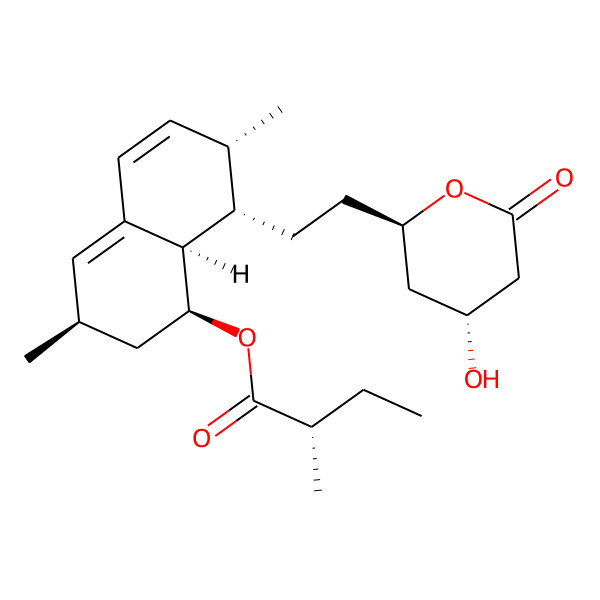Lovastatin
Function
DrugBank ID:
Description:
Lovastatin, also known as the brand name product Mevacor, is a lipid-lowering drug and fungal metabolite derived synthetically from a fermentation product ofAspergillus terreus.Originally named Mevinolin, lovastatin belongs to the statin class of medications, which are used to lower the risk of cardiovascular disease and manage abnormal lipid levels by inhibiting the endogenous production of cholesterol in the liver.More specifically, statin medications competitively inhibit the enzyme hydroxymethylglutaryl-coenzyme A (HMG-CoA) Reductase,which catalyzes the conversion of HMG-CoA to mevalonic acid and is the third step in a sequence of metabolic reactions involved in the production of several compounds involved in lipid metabolism and transport including cholesterol, low-density lipoprotein (LDL) (sometimes referred to as "bad cholesterol"), and very low-density lipoprotein (VLDL). Prescribing of statin medications is considered standard practice following any cardiovascular events and for people with a moderate to high risk of development of CVD, such as those with Type 2 Diabetes. The clear evidence of the benefit of statin use coupled with very minimal side effects or long term effects has resulted in this class becoming one of the most widely prescribed medications in North America.Lovastatin and other drugs from the statin class of medications includingatorvastatin,pravastatin,rosuvastatin,fluvastatin, andsimvastatinare considered first-line options for the treatment of dyslipidemia.Increasing use of the statin class of drugs is largely due to the fact that cardiovascular disease (CVD), which includes heart attack, atherosclerosis, angina, peripheral artery disease, and stroke, has become a leading cause of death in high-income countries and a major cause of morbidity around the world.Elevated cholesterol levels, and in particular, elevated low-density lipoprotein (LDL) levels, are an important risk factor for the development of CVD.Use of statins to target and reduce LDL levels has been shown in a number of landmark studies to significantly reduce the risk of development of CVD and all-cause mortality.Statins are considered a cost-effective treatment option for CVD due to their evidence of reducing all-cause mortality including fatal and non-fatal CVD as well as the need for surgical revascularization or angioplasty following a heart attack.Evidence has shown that even for low-risk individuals (with <10% risk of a major vascular event occurring within 5 years) statins cause a 20%-22% relative reduction in major cardiovascular events (heart attack, stroke, coronary revascularization, and coronary death) for every 1 mmol/L reduction in LDL without any significant side effects or risks.While all statin medications are considered equally effective from a clinical standpoint,rosuvastatinis considered the most potent; doses of 10 to 40mgrosuvastatinper day were found in clinical studies to result in a 45.8% to 54.6% decrease in LDL cholesterol levels, while lovastatin has been found to have an average decrease in LDL-C of 25-40%.Potency is thought to correlate to tissue permeability as the more lipophilic statins such as lovastatin are thought to enter endothelial cells by passive diffusion, as opposed to hydrophilic statins such aspravastatinandrosuvastatinwhich are taken up into hepatocytes through OATP1B1 (organic anion transporter protein 1B1)-mediated transport.Despite these differences in potency, several trials have demonstrated only minimal differences in terms of clinical outcomes between statins. [DrugBank]
Targets:
3-hydroxy-3-methylglutaryl-coenzyme A reductase (Humans); Integrin alpha-L (Humans); Histone deacetylase 2 (Humans) [DrugBank]
Pharmacodynamics:
Lovastatin is an oral antilipemic agent which reversibly inhibits HMG-CoA reductase. It is used to lower total cholesterol, low density lipoprotein-cholesterol (LDL-C), apolipoprotein B (apoB), non-high density lipoprotein-cholesterol (non-HDL-C), and trigleride (TG) plasma concentrations while increasing HDL-C concentrations. High LDL-C, low HDL-C and high TG concentrations in the plasma are associated with increased risk of atherosclerosis and cardiovascular disease. The total cholesterol to HDL-C ratio is a strong predictor of coronary artery disease and high ratios are associated with higher risk of disease. Increased levels of HDL-C are associated with lower cardiovascular risk. By decreasing LDL-C and TG and increasing HDL-C, lovastatin reduces the risk of cardiovascular morbidity and mortality.5,13,14,30 [DrugBank]
Structures
Docking in target protein
Off-target analysis based on ligand similarity (Homo sapiens)
Step 1 - Target prediction for Lovastatin: SwissTargetPrediction
Tips: Click on the link to jump to the 'SwissTargetPrediction' webserver. Select the species of 'Homo sapiens', and then paste the SMILES of Lovastatin in the SMILES input box.
Step 2 - Blind docking for Lovastatin: CB-Dock
Tips: Click on the link to jump to the 'CB-Dock' webserver. Upload the structure file of target predicted by 'SwissTargetPrediction' and the 2D/3D structure file of Lovastatin to perform blind docking.
